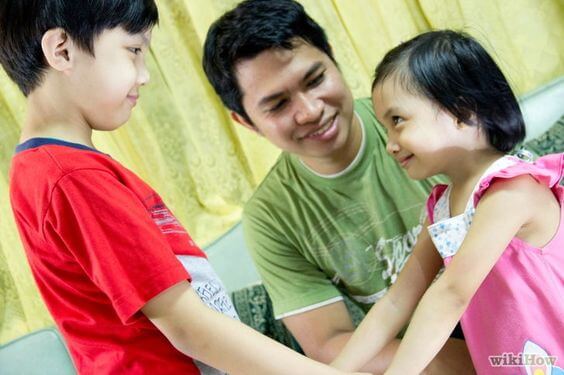What is Selective Mutism in Children?

Selective mutism is a more common condition than we might think. For many children, it has a sudden onset, but not every parent recognizes it as a disease. Selective mutism refers to when children choose to remain silent in different contexts, even when they know how to speak.
The way we treat our children when these episodes occur is not always the right way. Selective mutism can lead to stress and make us lose our patience. However, psychologists point out that in fact, it is a disorder that must be treated to avoid complications. That is, if we stop reacting to selective mutism, it can worsen.
Specialists suggest that we visit a professional when we notice the symptoms of this condition. Below we will tell you how selective mutism manifests and how to act if your child shows signs of selective mutism.
Symptoms of Selective Mutism

Psychologists explain that selective mutism is not only manifested by having isolated episodes in which the child does not want to talk. Other signs may indicate that your child is suffering from this condition. The main symptoms include:
- Anxiety in the presence of strangers or people they don’t deal with regularly
- Shyness most of the time
- Total inability or difficulty speaking in certain contexts, for example when arriving at school, in the park and in public places in general. However, at home the child may demonstrate the ability to talk and socialize with close friends and family members.
To determine if this disorder affects your child, you should notice if the child acts this way for more than a month. It is possible to confuse the symptoms if they occur on the child’s first days of class or when integrating to a new environment.
It is normal for some children to act shy or seem unwilling to speak in certain settings. The real problem occurs when the behavior is repeated and continues for months.
How to treat selective mutism
The key to helping our children overcome selective mutism is in the way we act in the midst of these episodes. If we don’t have enough tact, we could inadvertently cause psychological damage, because it is something they can’t control. To improve the situation, experts recommend the following steps.
“A clear environment makes the meaning more easily accessible”
-J. G. T. Van Dalen-
- Balance your child’s social relationships, as stable personal conditions must exist. In this regard, it is convenient for family and close friends to be aware of the problem, so that they can collaborate to overcome it
- Join study groups, invite friends over and encourage them to spend time with children their age
- A determining factor in the solution is to reinforce the child’s self-esteem. Avoid overprotection, which may limit their self-confidence. Letting them do small tasks by themselves will help them to trust their abilities; In addition, the tasks will be a topic of conversation

- Openly valuing the merits of your child helps them to be aware that everyone knows their qualities, and is therefore respected
- Adapting the conversation between parents and children is paramount in these cases. Listen carefully so they have confidence and interest in speaking to you. Sometimes our children don’t talk to us because they presume that we aren’t paying attention to them.
- Encouragement when they communicate well is as important as when they don’t communicate. Avoid criticism when your child does’t communicate. Remember that our aim is to encourage them to act and leave behind their silence, not to seek perfection
- Comparisons with siblings or other children are detrimental in this scenario. Let them talk when they want to and not because they should do what others do.
- Avoid labeling them as “shy” when they show symptoms. Labels are as harmful as pressure and repression.
Selective mutism is a more common condition than we might think. For many children, it has a sudden onset, but not every parent recognizes it as a disease. Selective mutism refers to when children choose to remain silent in different contexts, even when they know how to speak.
The way we treat our children when these episodes occur is not always the right way. Selective mutism can lead to stress and make us lose our patience. However, psychologists point out that in fact, it is a disorder that must be treated to avoid complications. That is, if we stop reacting to selective mutism, it can worsen.
Specialists suggest that we visit a professional when we notice the symptoms of this condition. Below we will tell you how selective mutism manifests and how to act if your child shows signs of selective mutism.
Symptoms of Selective Mutism

Psychologists explain that selective mutism is not only manifested by having isolated episodes in which the child does not want to talk. Other signs may indicate that your child is suffering from this condition. The main symptoms include:
- Anxiety in the presence of strangers or people they don’t deal with regularly
- Shyness most of the time
- Total inability or difficulty speaking in certain contexts, for example when arriving at school, in the park and in public places in general. However, at home the child may demonstrate the ability to talk and socialize with close friends and family members.
To determine if this disorder affects your child, you should notice if the child acts this way for more than a month. It is possible to confuse the symptoms if they occur on the child’s first days of class or when integrating to a new environment.
It is normal for some children to act shy or seem unwilling to speak in certain settings. The real problem occurs when the behavior is repeated and continues for months.
How to treat selective mutism
The key to helping our children overcome selective mutism is in the way we act in the midst of these episodes. If we don’t have enough tact, we could inadvertently cause psychological damage, because it is something they can’t control. To improve the situation, experts recommend the following steps.
“A clear environment makes the meaning more easily accessible”
-J. G. T. Van Dalen-
- Balance your child’s social relationships, as stable personal conditions must exist. In this regard, it is convenient for family and close friends to be aware of the problem, so that they can collaborate to overcome it
- Join study groups, invite friends over and encourage them to spend time with children their age
- A determining factor in the solution is to reinforce the child’s self-esteem. Avoid overprotection, which may limit their self-confidence. Letting them do small tasks by themselves will help them to trust their abilities; In addition, the tasks will be a topic of conversation

- Openly valuing the merits of your child helps them to be aware that everyone knows their qualities, and is therefore respected
- Adapting the conversation between parents and children is paramount in these cases. Listen carefully so they have confidence and interest in speaking to you. Sometimes our children don’t talk to us because they presume that we aren’t paying attention to them.
- Encouragement when they communicate well is as important as when they don’t communicate. Avoid criticism when your child does’t communicate. Remember that our aim is to encourage them to act and leave behind their silence, not to seek perfection
- Comparisons with siblings or other children are detrimental in this scenario. Let them talk when they want to and not because they should do what others do.
- Avoid labeling them as “shy” when they show symptoms. Labels are as harmful as pressure and repression.
All cited sources were thoroughly reviewed by our team to ensure their quality, reliability, currency, and validity. The bibliography of this article was considered reliable and of academic or scientific accuracy.
- Rodríguez, José. (2018). Mutismo selectivo. Naturaleza, evaluación y tratamiento.
- Rodríguez, José & X. Méndez, Francisco & Macià, Diego. (1996). Mutismo Selectivo. Un Modelo Explicativo. Behavioral Psychology/Psicologia Conductual. 4.
- Rodríguez, José & Rosa-Alcázar, Ana & Olivares, Pablo José. (2007). Tratamiento psicológico del mutismo selectivo.
This text is provided for informational purposes only and does not replace consultation with a professional. If in doubt, consult your specialist.








